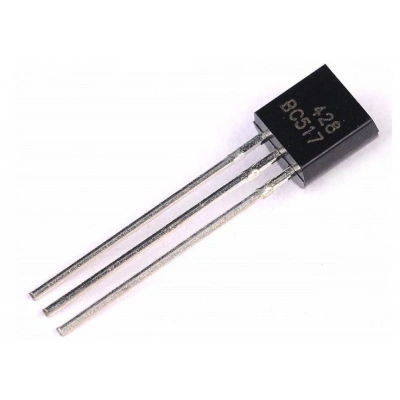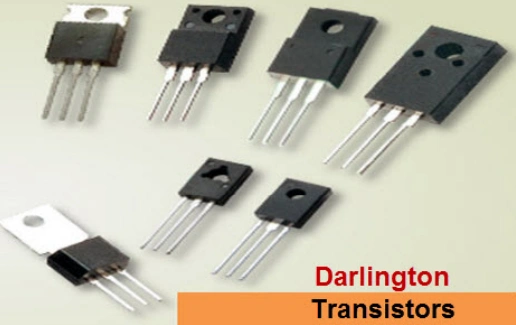OUTLINE:
Transistors Design and Functionality
 483
483Hey there, budding electronics enthusiasts! Ever wondered what makes your gadgets tick and tock with such finesse?
Well, get ready to meet the dynamic duo of Darlington transistors – the superhero sidekicks of the electronic world!
Think of them as Batman and Robin, but in semiconductor form (minus the capes, of course).
In this electrifying journey, we'll unravel the mysteries of Darlington transistors, from their quirky quirks to their electrifying applications.
So grab your popcorn, because we're about to embark on a transistor tale like no other!

Image Source: Chipmart.com
What Is the Definition of Darlington Transistor
A Darlington transistor is a semiconductor device consisting of two bipolar transistors connected in a specific configuration to amplify current or switch high currents with minimal input current.
It combines the high current gain of each individual transistor to achieve an overall higher current gain, making it suitable for applications requiring high power amplification or switching.
The Darlington configuration provides a high input impedance and low output impedance, making it useful in a wide range of electronic circuits, including amplifiers, motor drivers, and power switches.
What Is A Darlington Transistor Used for
Darlington transistors are commonly used in applications where high current amplification or switching is required. Some of the main uses include:
Amplification: Darlington transistors are utilized in audio amplifiers, power amplifiers, and sensor interfacing circuits where small input signals need to be amplified to drive high-power output devices such as speakers or motors.
Switching: They are employed in relay drivers, motor drivers, and power switching circuits to control high-current loads efficiently. Darlington transistors can handle higher currents than individual transistors, making them suitable for switching applications.
Buffering: They serve as buffers or drivers in digital circuits to provide additional current drive capability, ensuring that signals can be transmitted over longer distances or to multiple devices without signal degradation.
Voltage Regulation: Darlington transistors are used in voltage regulator circuits to regulate output voltage and provide stable power supplies for electronic devices and circuits.
Instrumentation: They are utilized in instrumentation circuits, such as oscilloscope vertical amplifiers and signal conditioning circuits, to accurately amplify weak signals for measurement or analysis purposes.
Pulse Generation: Darlington transistors are employed in pulse generators and timing circuits to generate precise and controlled pulses of varying widths and frequencies.
What Are the Advantages of Darlington Transistors
Darlington transistors offer several advantages, making them suitable for various electronic applications:
High Current Gain: Darlington transistors provide a significantly higher current gain than individual transistors. By cascading two transistors in the Darlington configuration, the overall current gain is the product of the gains of both transistors, resulting in a much higher gain than either transistor alone.
High Input Impedance: The Darlington configuration offers a high input impedance, which means that it requires minimal input current to drive the transistor pair. This property makes Darlington transistors suitable for use in circuits with weak input signals or high impedance sources.
Low Saturation Voltage: Darlington transistors typically have a lower saturation voltage compared to individual transistors. This allows them to switch high currents with minimal voltage drop across the transistor, reducing power dissipation and improving efficiency in switching applications.
Enhanced Stability: The Darlington configuration provides better thermal stability and linearity compared to single transistors. This results in improved performance and reliability, particularly in high-power amplifier circuits.
Single Package Solution: Darlington transistors are often available in single packages containing both transistors in the Darlington configuration. This simplifies circuit design and assembly, reducing component count and board space requirements.
Cost-Effectiveness: Despite offering higher performance than individual transistors, Darlington transistors are generally cost-effective due to their mass production and availability in integrated packages.
Wide Range of Applications: Due to their high current gain, low input current requirements, and versatility, Darlington transistors find applications in a wide range of electronic circuits, including amplifiers, motor drivers, power switches, voltage regulators, and more.
Is a Darlington Transistor Actually A Mosfet[FAQ]
The answer is:
No, a Darlington transistor is not a MOSFET (Metal-Oxide-Semiconductor Field-Effect Transistor).
A Darlington transistor is a type of bipolar junction transistor (BJT) configuration, consisting of two bipolar transistors connected in a specific way to achieve higher current gain.
In a Darlington configuration, the emitter of the first transistor is connected to the base of the second transistor, effectively cascading the two transistors to provide a much higher current gain than either transistor alone.
Darlington transistors are commonly used in applications requiring high current amplification or switching.
On the other hand, a MOSFET is a different type of transistor that operates based on the principle of field-effect.
It consists of a metal gate separated from a semiconductor channel by a thin oxide layer.
MOSFETs are known for their high input impedance, fast switching speed, and low power consumption.
They are widely used in various electronic circuits, including amplifiers, switching regulators, power supplies, and digital logic circuits.
While both Darlington transistors and MOSFETs are used for amplification and switching purposes, they are based on different principles of operation and have distinct characteristics and applications.
The Examples of Darlington Transistors

Image Source:EIprocCus
Some common examples of Darlington transistors include:
TIP120: The TIP120 is a popular NPN Darlington transistor commonly used in high-power switching applications, such as motor drivers, relay drivers, and solenoid drivers. It can handle a maximum collector current of 5A and a maximum collector-emitter voltage of 60V.
TIP122: Similar to the TIP120, the TIP122 is an NPN Darlington transistor with higher current and voltage ratings. It is suitable for applications requiring higher power handling capabilities, such as power supplies, DC motor control, and audio amplifiers.
TIP3055: The TIP3055 is a widely used NPN Darlington transistor with a higher current rating, making it suitable for high-power applications such as power amplifiers, voltage regulators, and DC motor control circuits. It can handle a maximum collector current of 15A and a maximum collector-emitter voltage of 60V.
TIP31C: The TIP31C is a general-purpose NPN Darlington transistor commonly used in low to medium-power amplification and switching circuits. It is suitable for applications such as audio amplifiers, LED drivers, and relay drivers. It can handle a maximum collector current of 3A and a maximum collector-emitter voltage of 100V.
TIP41C: Similar to the TIP31C, the TIP41C is a general-purpose NPN Darlington transistor with higher power handling capabilities. It is suitable for applications requiring higher current and voltage ratings, such as power amplifiers, voltage regulators, and motor control circuits. It can handle a maximum collector current of 6A and a maximum collector-emitter voltage of 100V.
Conclusion
In conclusion, our exploration into the design and functionality of Darlington transistors reveals their significance in the realm of electronics.
These unique semiconductor devices, with their cascaded configuration of two bipolar transistors, offer exceptional current gain and versatility in amplification and switching applications.
From motor control to power regulation, Darlington transistors play a pivotal role in various electronic circuits, providing reliability and efficiency.
By understanding the intricacies of their design and operation, we gain insight into their widespread use and potential for innovation in electronic engineering.
Thus, the Darlington transistor stands as a cornerstone of modern electronics, driving progress and powering technological advancements.

Disclaimer: The views and opinions expressed by individual authors or forum participants on this website do not represent the views and opinions of Chipsmall, nor do they represent Chipsmall's official policy.

share this blog to:

